Insurance 101: Understanding Catastrophe Bonds (CAT Bonds)
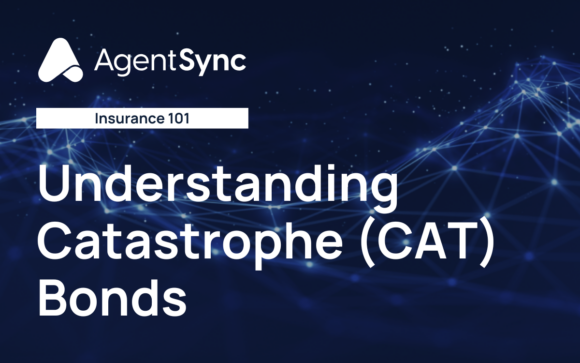
This post is part of a series sponsored by AgentSync.
Since the mid ’90s, insurers have used catastrophe bonds (CAT bonds) to provide a financial safety net in response to cataclysmic events like hundred-year floods, category four and five hurricanes, major wildfires, and even terrorism.
Disaster films are very popular in America. Twister, The Perfect Storm, and The Day After Tomorrow were all box office hits that drove flocks of moviegoers to witness carnage on the big screen from the safety of their cushy theater seats (despite the sticky, popcorn-butter-soaked floor). Unfortunately, in recent years, these cinematic catastrophes have been coming to life. And as the insurance industry tries to help people who’re impacted, the industry itself isn’t safe from the consequences of increased catastrophic events.
CAT bonds are the most popular investment instrument carriers use within the burgeoning Insurance-Linked Securities (ILS) market, which consists of products created to help the insurance industry handle enormous financial setbacks resulting from the most extreme circumstances. Reinsurance sidecars and life insurance securitization are two other investment vehicles included in the ILS market, but here we’ll just cover CAT bonds as they are currently the most widely used.
What are CAT bonds and why would an insurance carrier issue them? We’ll cover these questions, discuss how and why these bonds were conceived, and what the future holds for this high-yield bond.
What are catastrophe bonds (CAT bonds)?
These bonds are unique debt instruments that convey risk from a sponsor to investors. CAT bonds can be a “last resort” for insurers in a catastrophic situation like Hurricane Katrina when claims can push a carrier toward insolvency.
As the name implies, catastrophe bonds (CAT bonds) are geared toward financially devastating events that affect both businesses (including insurers) and private citizens. For example, the “once in 100 years hurricanes” we used to believe happened every century are now annual events. These storms have put a considerable financial strain on the insurance industry worldwide. Due to the frequency and enormity of the disasters we’re now facing, many insurers are looking for stronger financial backing above and beyond traditional reinsurance policies.
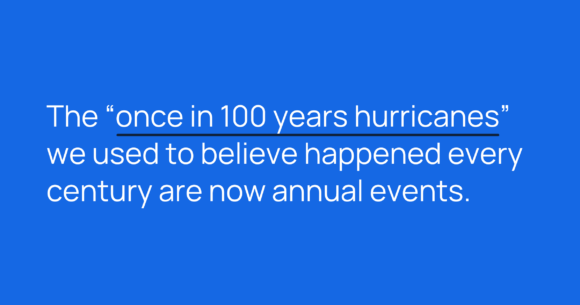
CAT bonds are high-yield bonds that are, in large part, non-investment grade bonds. Investment grade ratings are important because they help the investor understand the risks involved. Credit rating agencies like Moody’s and Standard & Poors (S&P) rate bonds according to bond risk variables, and CAT bonds tend to fall into the riskier category. They’re sometimes labeled “junk” bonds, which is a Wall Street term for a high-risk bond; however, some CAT bonds have crept into investment-grade territory. These investments are also more often variable rate bonds and can mature anywhere from one to five years, but most mature at the three-year mark.
Important aspects of CAT bonds
In order to understand the basics of a CAT bond, there are a few terms that are helpful to know. In some cases, investment instruments such as these can be multifaceted, and have special nuances that are particular to that bond deal. However, the following should help you gain a solid foundational knowledge.
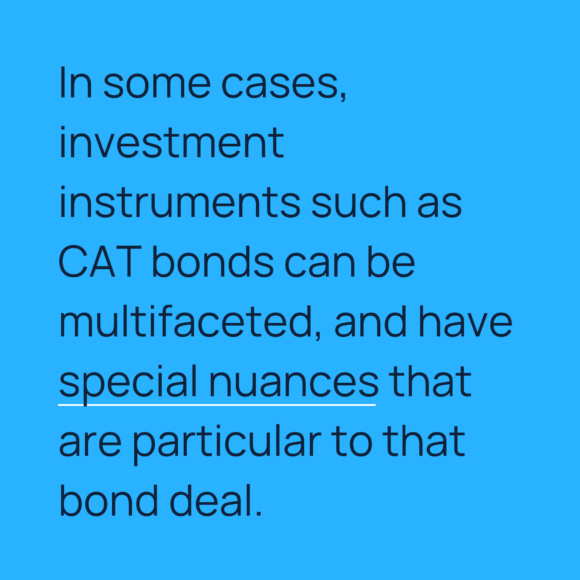
Sponsors
A sponsor is the organization that issues a bond to the investor market. This can be a carrier, a reinsurer, a state catastrophe fund, a country, a non-profit, or even a corporation. An example of a state catastrophe fund is the California Earthquake Authority (CAE), which has sponsored numerous CAT bonds over the years in order to protect insurers in the event of a major earthquake.
Another example of a sponsor is search engine giant Google, which has issued three CAT bonds since 2020. While Google (and its parent company, Alphabet, Inc.) are not insurance companies, they issued CAT bonds to protect corporate operations in California. The technology giant could face substantial losses in the event of a catastrophic earthquake and it appears they felt the ILS market was their best bet for financial security.
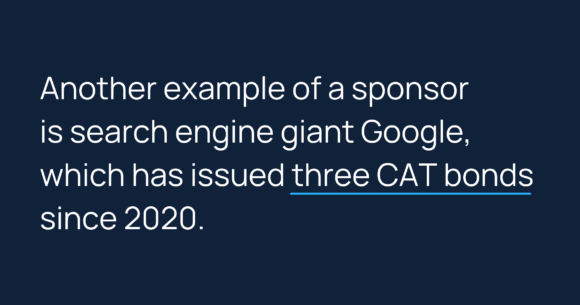
Investors
Hedge funds and institutional investors are keen on these instruments for a variety of reasons, namely their high yields. In general, this is not a “mom and pop” bond as CAT bond complexity requires a good deal of due diligence and sophistication before investing. In fact, a married “mom and pop” filing jointly will need a combined income that exceeds $300,000 for the two most recent tax-filing years or a joint net worth that exceeds $1 million. If it’s just mom or just dad, he or she needs $200,000 in income and still would need a million dollars in net worth. These investors would be considered accredited, as they meet the requirements, and would be able to purchase CAT bonds.
CAT bonds are also separated from the general stock market’s performance, which assists with portfolio diversification. To a CAT bond investor, keeping tabs on major weather events is more relevant than the ups-and-downs of the Dow Jones or S&P 500. The majority of CAT bond investors are located in the United States, but buyers worldwide also participate in this market.
Specified set of risks
Risks, as they pertain to the CAT bond definition, are the risks bondholders face that could trigger payment to the sponsor. These risks include major natural disasters such as earthquakes, floods, windstorms, tornados, and hurricanes.
Special-purpose vehicle/special-purpose insurers
The SPV/SPI is “bankruptcy remote” (isolates financial risk for the sponsor) and has the legal authorization to act as the insurer. This means it is actually able to write reinsurance. In many instances, these vehicles are domiciled in Bermuda, Cayman Islands, or Ireland. Malta is on the map as well. The reasons for these exotic locales are tax and accounting purposes – as one source put it, SPVs find a home in Bermuda because of the country’s “adaptive regulatory environment.” Local legislation in these countries offer the CAT bond sponsor favorable benefits that cannot be obtained in the United States or other countries with tighter regulations.
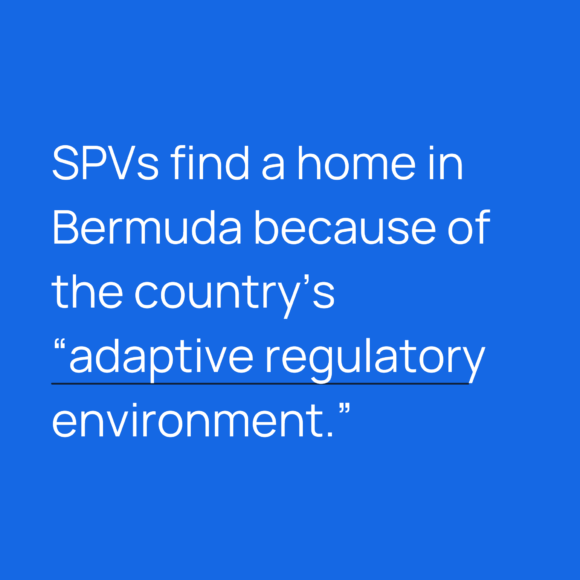
How to set up a CAT bond
Let’s begin with a simple hypothetical scenario in which the sponsor is an insurer. This particular insurance company has a problem. Many of its customers own homes in hurricane prone counties in Louisiana and they’re concerned if another Category 5 smashes into these areas, they’ll have some serious financial problems on their hands. After much deliberation, the company decides to try the CAT bond market to help shore up its financial defenses against potential hurricane force winds blowing down their doors (or rather tearing up their balance sheets).
Creating and issuing a CAT bond requires setting up multiple special entities and hiring various professionals who are important in the creation and sale of the bond.
CAT bonds are intricate financial debt instruments, however, the basic elements can be broken down into the following phases:
Creating a SPV/SPI. In this example, this hypothetical insurer is looking for help reducing its risk of hurricane-induced losses. It creates an SPV that acts as the intermediary between bond investors and the insurer. This vehicle is the center of the action between investors, the insurer, and trust accounts (which we discuss later on). The insurer pays premiums into the SPV and, if a catastrophic event is triggered, the principal amount (provided by the investors) will flow to the insurer from the SPV.
Setting up a trust. When bonds are sold, the principal is collected in the SPV and placed in a trust, which can then be reinvested into low-risk accounts like a money market. Returns from this external trust vehicle flow back to the SPV and on to investors in the form of variable rate payments. To sweeten the pot, investors also receive a premium payment through the SPV from the sponsor for bearing the risk of losing their principle in the event of a catastrophe.
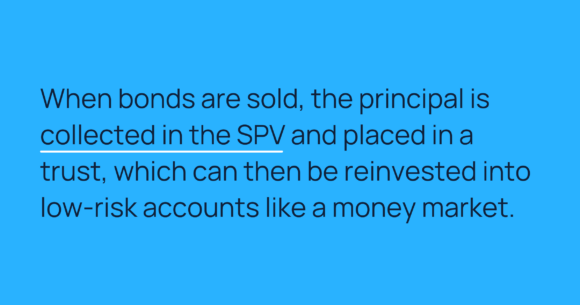
Selecting a structuring agent. The sponsor selects a structuring agent, typically an investment bank, to assist with the bond design and sales. The bond purchasers buy from the structuring agent, who is licensed to sell bonds. An independent modeling agent is essential to craft models to forecast sponsor event risks, and they work alongside attorneys to ensure securities compliance. As you can see, there are a few “cooks in the kitchen” when structuring and issuing a CAT bond.
Determining the trigger. The structuring agent and sponsor then work together on the sponsor protection dollar amount and select the triggering event that will activate a payout to the sponsor from bond investors. In addition, the trigger has to occur within the time frame agreed upon in the contract. Many of these trigger events are tricky to substantiate and some require independent third parties to confirm the aggregate dollar amounts. An example is Property Claims Service (PCS), which assists with data verification.
What are CAT bond triggers?
A “trigger” precipitates payout from bondholders to the CAT bond sponsor. The most common are indemnity and industry loss triggers, followed by parametric and modeled loss triggers.
Depending on how the bond is constructed, the payout to a sponsor after the trigger occurs is either a portion of the principal of the bond or the whole amount. If a trigger is activated, bond holders could lose their investment. If a specific triggering event does not occur within the agreed upon time frame, investors then recieve their principal back at the bond maturity date. Famed author and financial journalist Michael Lewis has dubbed this world of investing as gambling in “Nature’s Casino.”
Types of CAT bond triggers
There are several types of triggers in the world of CAT bonds. These include:
Indemnity triggers
The indemnity trigger activates a payout to the sponsor based upon what losses are suffered by the actual sponsor. This trigger may result in a longer payout process to the issuing sponsor of the bond due to the length of time it can take to verify the sponsor’s actual losses. A catastrophe is complex and messy and the insurance portion is no different. Despite this, indemnity incidents along with industry loss events are the most common triggers for CAT bonds.
Industry loss triggers
The industry loss trigger activates a payout to the sponsor based upon what the insurance industry as a whole loses as a result of a catastrophic event. The losses must exceed an amount, called an attachment point, which the sponsor sets beforehand. Again, data collection on this trigger can take a long time to compile as data trickles in after a serious disaster. State governments and individual insurers will release initial assessments, but this number often changes as more facts and data points are compiled.
Parametric triggers
A less common trigger, the parametric trigger, is activated when an event surpasses a certain predetermined threshold. For example, if an earthquake is equal to or greater than 5.0 on the Richter Scale or hurricane wind speeds are more than 120 mph. These measurements are easier to confirm quickly with modern technology, resulting in faster payouts to sponsors.
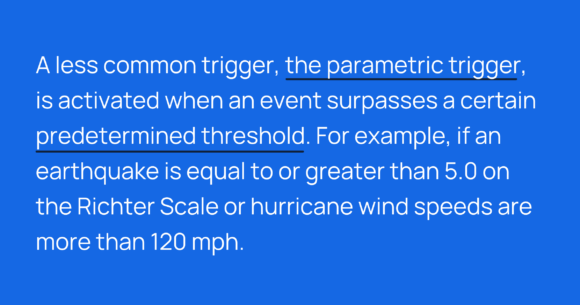
Modeled triggers
These triggers are similar to indemnity tiggers with one major difference. Rather than being based on actual claims, this trigger relies on computer and/or third-party models. These models are estimations and will render data much faster than the indemnity tiggers. Modeled triggers only compose around 1 percent of the current trigger mechanism pie, and were more common in the early years of CAT bond development.
In addition to the above types of triggers, CAT bonds can be structured as per event or can provide coverage for multiple catastrophes over a specified period of time. For example, a trigger could be set off when a third hurricane strikes in a certain region within a specific time frame, or by combined losses from three named storms in a season. The sophistication level and creativity of triggers continues to evolve as much as the world’s weather does.
History of CAT bonds
The first CAT bond was introduced over 25 years ago by George Town Re Ltd. Interestingly enough, this debt instrument was triggered by multiple natural disasters resulting in a $1 million investor payout to its sponsor, St. Paul Re, to help cover claims. Fun fact: this loss would be over $1.8 million in 2022 dollars, thanks to inflation.
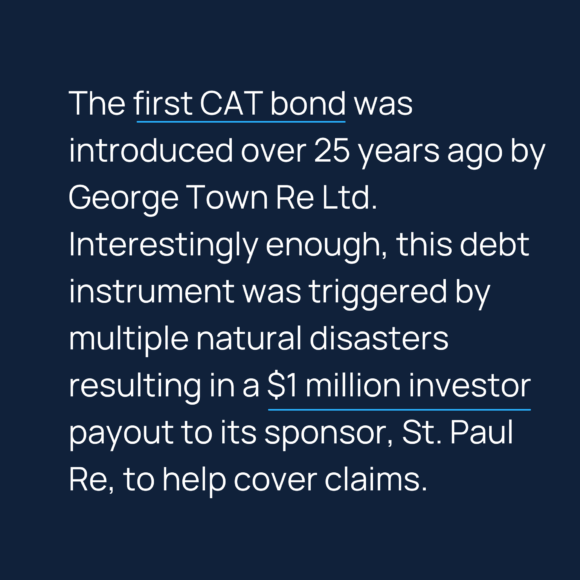
CAT bonds were created, in part, as a response to insurers’ staggering losses during Hurricane Andrew in 1992. At the time, it was the costliest natural disaster to ever strike the United States. Clocking in at over $25 billion in damages, Andrew and its ensuing wrath resulted in the failure of numerous insurance carriers. Further disasters such as the 1994 California Northridge Earthquake reinforced a sense of urgency within the insurance industry to find a solution for the largest and costliest situations.
Since then, the CAT bond market has bounced along steadily and somewhat quietly until Hurricane Katrina roared ashore in 2005. Katrina caused over $65 billion in insured losses, triggering an explosion in CAT bond growth, resulting in a 136% increase in issued bonds in 2006. The financial crisis of 2008 to 2009 resulted in a slowdown, especially in wake of the Lehman Brothers collapse, but bonds stormed back by 2010.
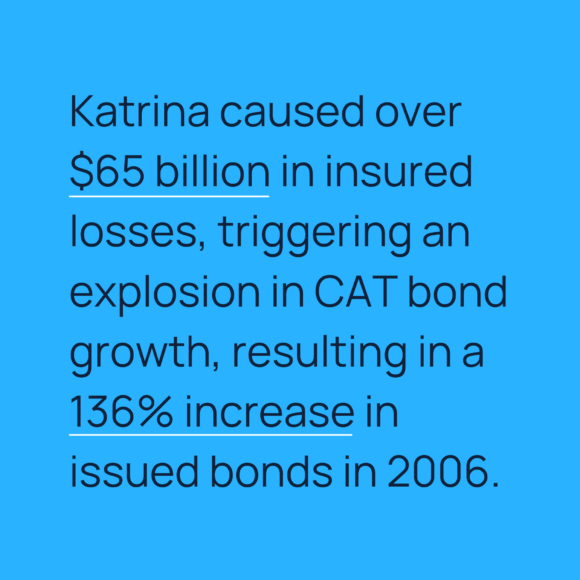
As the world grows even more dangerous, risks are expanding into other areas such as terrorism and pandemics. In fact, PoolRe, a U.K. terrorism reinsurer, issued the first CAT bond to cover insurance carrier losses suffered as a result of terrorist acts. A pandemic, in the wake of Covid-19, is now a real risk, and the appetite for pandemic CAT bonds is growing as well.
Taking full advantage of the high yields they so covet, institutional investors continue to place money into CAT bonds. Additionally, the insurance industry continues to use CAT bonds to buffer themselves as losses pile up from unabated disasters.
How do CAT bonds benefit carriers?
As losses mounted in the early ’90s insurance industry, Wall Street came to the rescue after other financial safety plans became inadequate. Reinsurance was just not enough anymore; the industry needed new options.
Obviously, the biggest CAT bond benefit is capital to keep a carrier solvent, but there are other advantages as well. The overall cost of capital can be lower for a sponsor if a carrier decides to explore this special bond market. A CAT bond helps an insurance carrier obtain money from a variety of different sources. For example, hedge funds will naturally compete with reinsurers, driving down reinsurance costs. As the pool of capital increases for a carrier to choose from, it creates more flexibility and options for CAT bond sponsors.
CAT bond deals are typically structured as multi-year agreements, whereas most reinsurance contracts are for a period of 12 months. The extended time afforded by a CAT bond allows the issuing sponsor to enjoy set prices for a longer period. Last but not least, insurers are also required to have a minimum reserve account on standby and these bonds assist in reducing that amount.
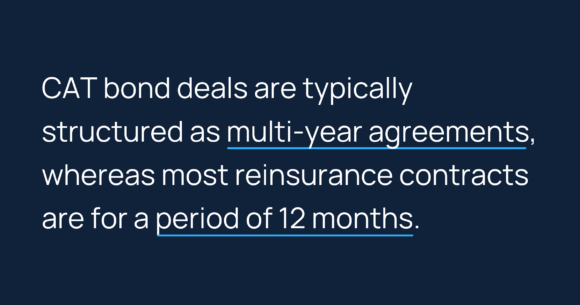
What does the future look like for CAT bonds?
The future of the CAT bond market appears to be strong; however, as with any financial instrument, it’s difficult to predict. As our climate changes and storms continue to grow stronger, it’s safe to say that more catastrophic events will unfold across the world. Humans also continue to build homes in areas that are prone to wildfires and hurricanes, resulting in costly disasters. CAT bonds may remain a popular solution for carriers as they seek alternative financial remedies for rising claims from damaging events.
In 2021, the CAT bond market reached new heights as $12.8 billion in new bonds were issued; numerous insurance companies entered the market for the first time. This new bond amount eclipsed 2020 numbers by 15 percent, which was also a record year. Also in 2021, The World Bank assisted the country of Jamaica with bringing a disaster bond to market.
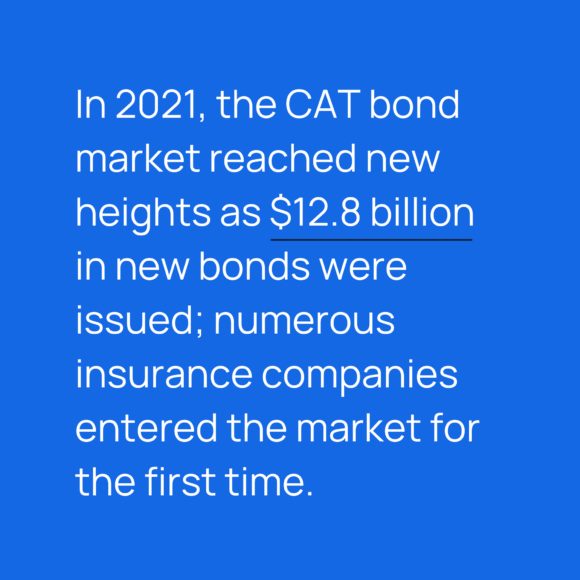
We are nearly halfway through 2022 and growth in the ILS market shows no signs of slowing.
One big question for the future is how rising inflation will affect the CAT bond market. Could interest rate increases significantly impact the market in 2023?
Bonds have an inverse relationship to interest rates that, at first look, could seem confusing. As interest rates rise, a fixed interest rate bond does not get investors as excited, so the bond price goes down. On the other hand, in a low interest rate environment (which has been most of the last two decades) fixed interest rate bonds become more attractive as the bond price increases. As of this writing, interest rates are rising sharply to combat inflation numbers the world has not seen in over 40 years.
This brings us to the CAT bond and how the current inflationary markets will impact them. As we mentioned earlier, these bonds are typically fixed, short-term, and high yield bonds. As rates rise, the price of the bond decreases, but bonds with shorter terms tend to be less sensitive to rate changes (CAT bonds are typically 3-5 years). Nevertheless, due to the changing financial environment, some feel that CAT bonds could approach eight or nine percent yields in 2023.
Please note that at AgentSync, we provide data-driven tech solutions to insurance businesses. While we hope you find our perspective useful and interesting, we aren’t providing legal or financial advice. Do your own research and due diligence to follow the guidelines and regulations of your jurisdiction. You’ll definitely want to hire outside counsel before investing in CAT bonds!
Whether you want to dive into the CAT bond market or not, let AgentSync help reduce your compliance risks and speed up your onboarding and licensing process. We can help insurance carriers, agencies, and MGAs lower operational costs and get producers and adjusters licensed faster. Check out our solutions today.
Topics
Catastrophe





